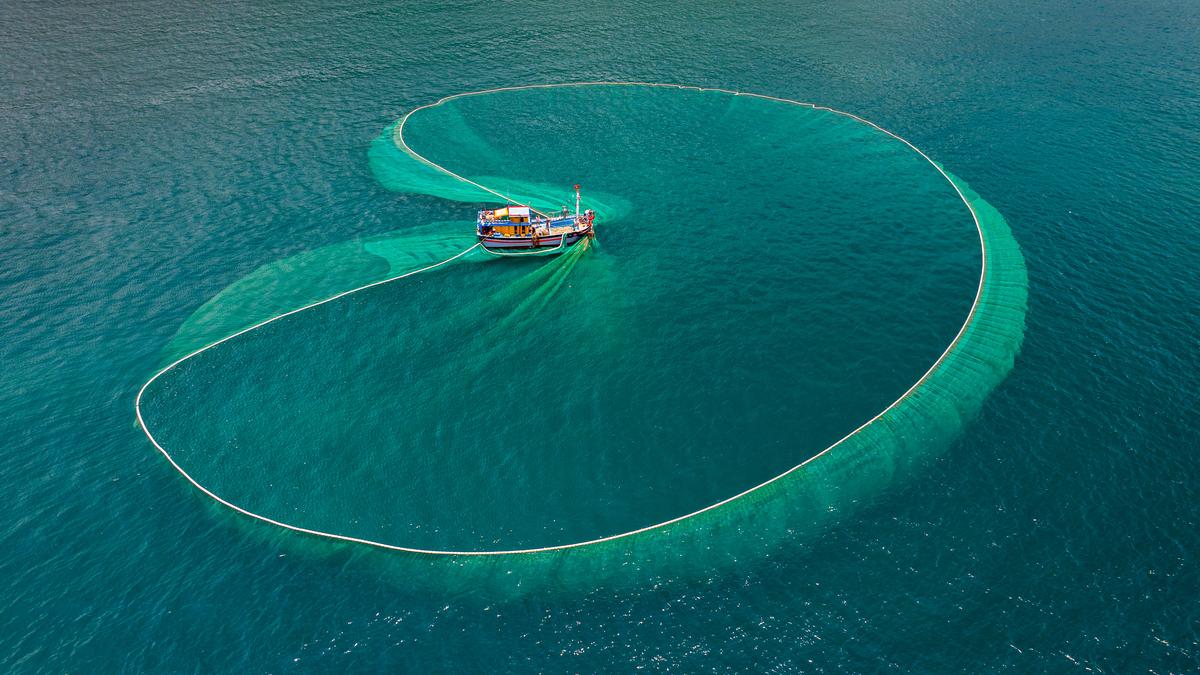Overfishing in India

- 23 May 2025
Context:
India, the second-largest fish-producing nation globally, contributes around 8% to world fish production. With an estimated marine fisheries potential of 5.31 million tonnes, India’s sector has reached its maximum sustainable yield, currently stabilizing at 3–4 million tonnes annually. However, this apparent success masks deep ecological and socio-economic distress, primarily due to overfishing.
Inequity and Overexploitation
Despite their 90% share in the fishing population, small-scale fishers harvest merely 10% of the total catch, while mechanised trawlers dominate volumes. This has left three-fourths of marine fisher families below the poverty line. Escalating the problem is the race to increase yields using more powerful engines and finer mesh nets—leading to marginal gains at steep ecological and financial costs.
Trawling operations, especially shrimp trawlers, demonstrate the magnitude of bycatch—where for every kilogram of shrimp, over 10 kg of juvenile and non-target species are discarded. Such practices degrade marine biodiversity, deplete spawning stocks, and destabilise food webs. Examples from Canada’s cod fishery (1992) and California’s sardine fishery collapse (1960s–80s) show the irreversible impacts of mismanaged stocks.
Policy Fragmentation and Regulatory Loopholes
Each coastal state in India governs its marine fisheries through its own Marine Fisheries Regulation Act (MFRA), resulting in a regulatory patchwork. Fishers exploit these inconsistencies—for example, landing juvenile fish legally in one state that are protected in another. This undermines conservation and facilitates laundering of protected species.
Moreover, the fish-meal and fish-oil (FMFO) industry fuels ecological damage by incentivising bycatch. Much of this low-value catch is processed into meal, mostly for export, depriving domestic consumers and aquaculture of vital nutritional inputs.
Government Initiatives
The Union Budget 2025–26 allocated a record ?2,703.67 crore to the fisheries sector, focusing on the sustainable harnessing of resources from the EEZ and high seas, especially around Lakshadweep and the Andaman & Nicobar Islands. Key schemes include:
- Pradhan Mantri MatsyaSampada Yojana (PMMSY): Focuses on inland fisheries and aquaculture for food security.
- Blue Revolution Scheme: Enhances productivity in marine and inland fisheries.
- Technological Interventions: Satellite-based vessel tracking, Oceansat for forecasting Potential Fishing Zones (PFZ), and GIS mapping are being deployed.
Path to Sustainability
India’s National Policy on Marine Fisheries (2017) embeds sustainability at its core, promoting measures like:
- 61-day uniform fishing bans during monsoons;
- Prohibitions on harmful methods like pair and bull trawling, and LED light usage;
- Promotion of mariculture, artificial reefs, and sea ranching.
Successful models abroad offer direction. New Zealand’s Quota Management System (QMS) aligns catch limits with stock assessments and uses transferable quotas to regulate fishing. India could pilot such a model for its mechanised fleet.
Domestically, Kerala’s enforcement of a Minimum Legal Size (MLS) for threadfin bream boosted catches by 41% in one season. Scaling such practices nationally can ensure ecological recovery and economic benefits.
Way Forward
India must urgently move towards a unified, science-based regulatory framework, including:
- National MLS norms,
- Gear restrictions to reduce juvenile catch,
- Scientific catch limits,
- Closed seasons aligned with spawning cycles.
Simultaneously, fisher cooperatives must be empowered, FMFO quotas capped, and consumer awareness campaigns launched to encourage demand for legally sized, sustainable seafood.
In conclusion, India stands at a critical juncture. Ignoring overfishing risks deepening poverty and ecological collapse. The solutions—rooted in science, equity, and sustainability—are within reach and must be swiftly implemented to safeguard marine wealth and livelihoods for future generations.
